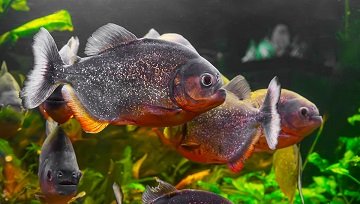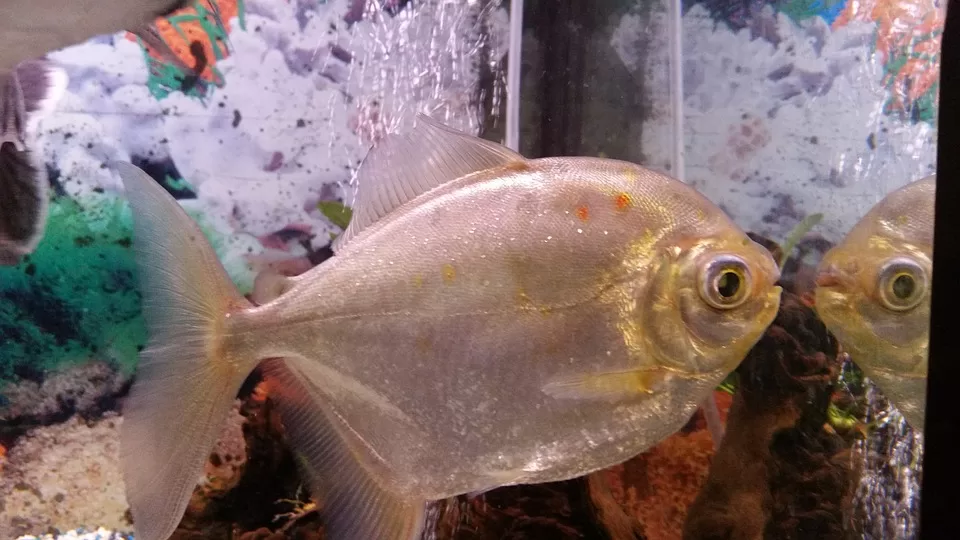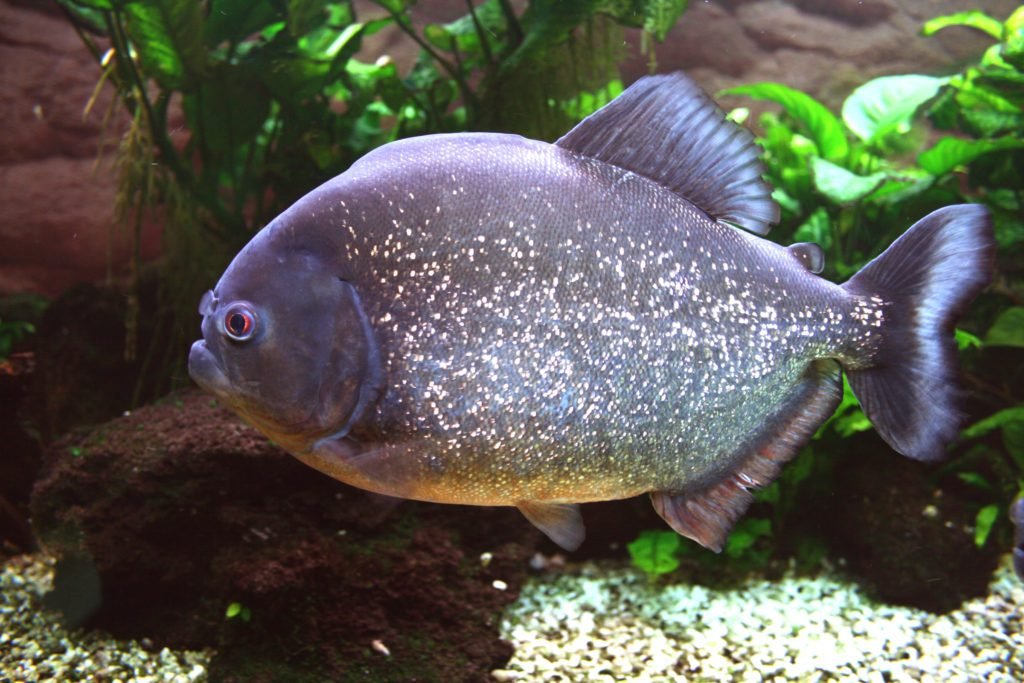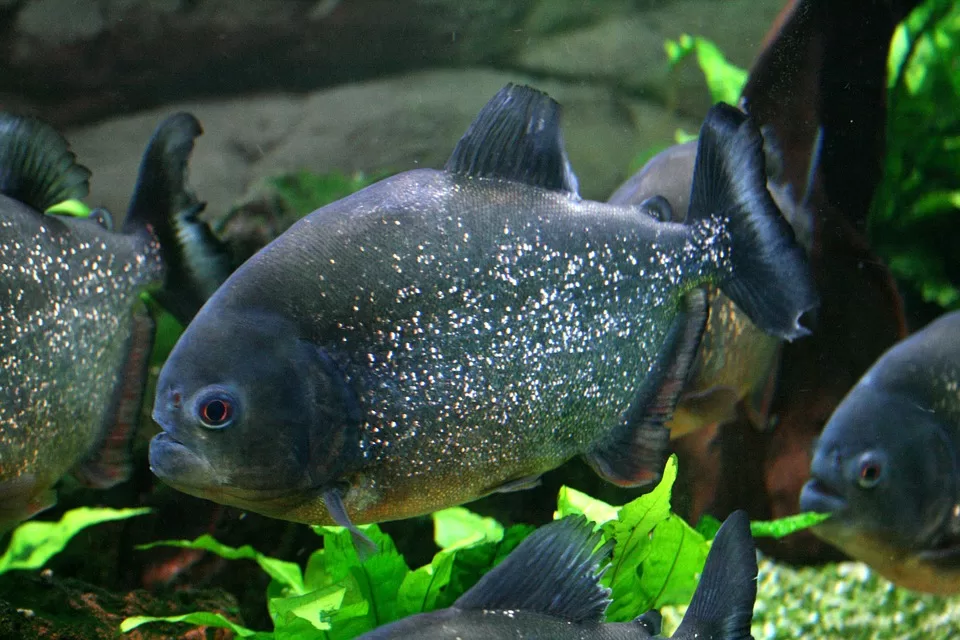Piranhas are one of the coolest pets you can own (If you know what you are doing of course)! And the best part, you don’t need to be a villain to keep a fish tank of full gnarly pet piranhas.
Pet fish ‘connoisseurs’ all over the world raise Piranhas regularly, and they happily report how they’re exciting animals to keep as pets.
There are dozens of different types of Piranhas in the wild, however, only a few are kept as pets due to their reduced aggressiveness and easier handling in captivity.
If you’re wondering how difficult they are to keep as pets, check out this article and you’ll learn everything you need to know to make the right choice!

Piranha fish as pets: Are They Dangerous?
The first issue that most people have with piranhas is the widespread fear of injuries they can cause.
You must keep in mind that they are indeed dangerous and could bite you if you’re not careful, but the common portrayal in horror movies of schools of young piranhas, devouring people in seconds is a myth.
Piranhas are actually shy, timid, and very nervous creatures. They prefer staying far away from large predators and, for the most part, they stay in their schools, not for hunting… but to feel safe and protected.
There are cases of Piranhas attacking humans in South America, however these are rare cases, caused by habitats changes due and alterations in environments. The provoked fish either felt threatened by humans or were stuck in a place without food for days.
Some species are more aggressive than others but as a general rule piranhas in an aquarium can cause small injuries with their biting but they won’t be fatal.
Is it Legal to Keep a Pet Piranha?
It mostly depends on local regulations in your country or state regulations and laws. That said, keeping piranhas is not a new thing. People have been fascinated by them for decades. I personally had a 6 or 8 of them in a small 20-gallon tank as a kid.
Can you have a pet piranha?
Keeping a Piranha is illegal in the Philippines, Malaysia, Germany, Mexico, Australia, and some states of the USA, so ask your local authorities before buying one or you could face a steep fine or possible jail time!

Affordable Aquarium Decorations
When setting up an aquarium for your pet piranha, it’s important to create an environment that mimics their natural habitat. Affordable and easy decorations could include aquatic plants, which not only add aesthetic appeal but also provide hiding spots for your piranha.
Smooth rocks and driftwood can also be used to create structures and caves, giving your piranha a sense of security. Remember, piranhas are shy and nervous creatures, so providing ample hiding places is crucial. Also, consider using a dark substrate to mimic the murky waters of their natural habitat. Lastly, ensure that the decorations are easy to clean, as piranhas can create a mess when they eat.
,
What’s the Best Species of Piranha to Keep as a Pet?
There are over 20 different species of piranhas, each with different characteristics and behaviors. The most common and the best type of piranha to keep as a pet is the Red Bellied Piranha.
The Red Bellied Piranha is considered ‘affordable’, easier to maintain, and they’re the least aggressive of the Piranha family. Plus, their colors are amazing – ranging from silver and gold fins and the eponymous red bellies.
For those seeking a more exotic species of piranhas, take a look at the Black Piranha (Serrasalmus Rhombeus) or the Ruby Red Piranha (Serrasalmus Maculatus)! Both are similar in behavior to the Red Bellied but breeders are scarce, so it’ll be harder to find them for sale.
What to Feed Them?
Red Bellied Piranhas are omnivores, in the wilderness, they mostly eat other smaller fish, crustaceans, and plant matter such as certain green vegetables like green peas or raw zucchini.
It’s true that piranhas kept in captivity can and do eat other fish!
Although you might find it interesting watching them slowly eat a larger fish – to keep piranha healthy you should feed them live or frozen fish or meat (also frozen foods prevents a nasty big mess every time they eat).

Also, most ‘feeder goldfish’ are not very nutritious for your Piranha, and they might carry diseases or parasites that can harm your pet.
Piranhas rarely like normal fish tank ‘fish food’, but give feeding it a try. If yours like it, it’ll benefit significantly from the nutrients they provide.
Otherwise, keep your piranha aquarium healthy with a balanced diet of feeder fish, frozen fish, freeze dried foods, small crustaceans, and small pieces of vegetable to replicate their wilderness environment.
Lone Piranhas and Potential Partners
If you’re going to keep a pet piranha you should know that they are normally very aggressive towards other species of fish, and in most cases… to other piranhas.
Keep your Piranhas in a separate tank to prevent them from eating your other fish.
Whether you keep the red belly piranha completely isolated, or a small school, depends on the size of your fish tank. A fish tank requires over 25 gallons of water per adult Red Bellied Piranha, and it’s recommended to have them in groups of three or more, since having only two may result in them fighting each other frequently for the dominant position.
The Serrasalmus species of Piranhas are better kept in solitary confinement, since they are very aggressive towards other fish, including other Serrasalmus.
The Black Piranha is especially aggressive fish lethal as it’s bite is much stronger than the others, making it extra dangerous. In generally, they do not attack unless they are hungry, but they have been known to bite if they feel threatened.

Piranha as a Pet: Where to Keep Them?
Because they require such large tanks, the main problem you might encounter with where to keep your pet Piranha, is finding the space in your home.
You need at least 25 gallons of water per adult Red Bellied Piranha, and their tank must be adequately acclimatized, have plants, and ample hiding places. For best quality of life, their tank should be large in size to accommodate behavior such as schooling. Avoid poor water quality by changing their water or carrying out a cleaning regularly. The tank water temperature, pH and other environmental parameters should be monitored daily.
For Black Piranhas and Ruby Red Piranhas you’ll need even bigger tanks, with each one taking over 40 gallons of water per adult fish.
Piranha Care & Maintenance
Despite their dietary requirements, piranhas are relatively low-maintenance fish when compared to most species of tropical fish. Piranha require clean, clear water at a specific temperature and pH range similar to other common fish species such as guppies or gold fish. You need to avoid exposing them to extreme heat or direct sun as they do not like warm water. They have a few special needs such as monitoring aggressive behavior and offering them live foods at least from time to time.
Fish tank maintenance is very similar to that of other more common fish. The exception, however, is that if you feed them live fish, you’ll need to change their water and filters frequently to adapt to the strewn body parts and the bloody mess they make. If you use tap water, you need to make sure you dechlorinate it first. Make sure you maintain good filtration, enough space to swim, some live plants and clean water so that they will not experience any health problems.

How Much Does a Piranha Cost?
When considering the cost of owning a pet piranha, it’s important to look beyond the initial purchase price of the fish, which can range from $30 to $100 or more. The weekly cost of feeder fish, a staple in the piranha’s diet, can add up to $2 to $4. Additionally, setting up a suitable aquarium environment can be a significant one-time expense, potentially ranging from $100 to $500.
Ongoing maintenance costs, including food and water conditioners, can add another $20 to $50 per month. It’s also wise to factor in potential veterinary costs and the time commitment required to properly care for a piranha.
Bottom Line, Should You Keep a Pet Piranha?
If you’re looking for an exciting adventure with an exotic pet, Piranhas will surprise you and keep you entertained for many years. However, keep in mind that they require special treatment and shouldn’t be treated lightly.
Once you have raised a Piranha successfully, you’ll see they’re amazing creatures with fascinating behaviors. And they are ALWAYS great conversation starters for anyone visiting your place.
What do you think about Piranhas? Do you have a pet Piranha and would like to share your experience? Disagree? Let us know in the comments.
This entry was posted in Tips, Dangerous, Fish and tagged 101, Good, Make, Pet, , Piranha, Piranhas.
Q: Can you have a piranha as a pet?
A: The legality of owning a piranha as a pet varies depending on local laws and regulations. In some regions, it is perfectly legal to own a piranha with the proper permits, while in others, it is strictly prohibited. It’s important to check with local wildlife or fish and game departments before purchasing a piranha to ensure you are in compliance with all local laws and regulations.


The Red Bellied Piranha is actually the MOST aggressive breed of Piranha according to most sources. This article said its the LEAST.